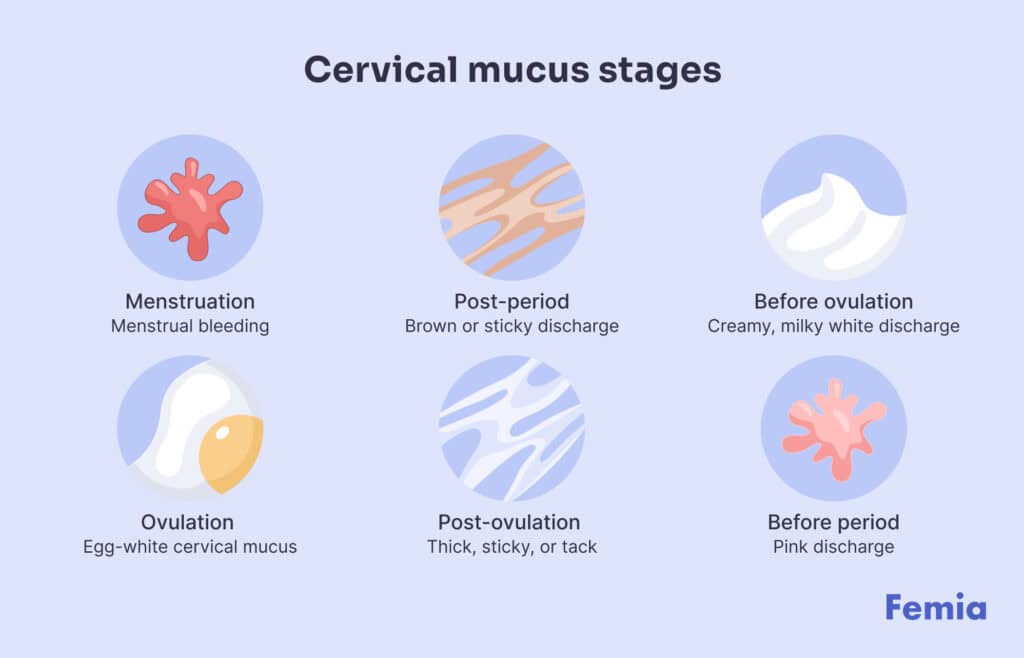Femia > Health Library > Your cycle > Health > Cervical mucus chart: Understanding the stages and tracking your cycle
Cervical mucus chart: Understanding the stages and tracking your cycle

- Updated Feb 10, 2025
- Published
CRAFTED BY HUMAN
Crafted by human At Femia, we provide accurate and up-to-date information at every stage of your journey, from trying to conceive, pregnancy and postnatal support. All content is created by a real person based on in-depth research and own professional experience. Femia ensures that you will receive expert advice, strict accuracy and a personalized approach from our authors/medical experts. Learn more about our editorial policy.
FACT CHECKED
Fact checked At Femia Health, we maintain the highest standards of editorial excellence in delivering content focused on helping you conceive, guiding you through pregnancy, and supporting you postpartum. Explore our content review principles to learn how we ensure the accuracy and quality of our health and lifestyle tips for every stage of your journey.
Cervical mucus changes throughout your menstrual cycle. The slippery, wet cervical fluid of ovulation plays a vital role in conception by helping sperm reach the egg faster. The thick, tacky mucus when you’re not ovulating acts as a barrier to prevent sperm from entering the uterus.
Tracking your cervical mucus can help you time sex to increase your chances of getting pregnant. Take note of your cervical fluid’s texture, color, and consistency daily to help you predict when ovulation is likely to occur.
Until you try to get pregnant, you probably haven’t given much thought to your cervical mucus before, but it can hold clues as to where you are in your cycle. However, tracking your vaginal discharge can help you figure out your fertile window, so you can time sex to increase the chance of conception (romantic, huh?).
You don’t need any special equipment or in-depth understanding to track your cervical fluid, so it’s a cheap and easy way to keep tabs on your cycle. Tracking your cervical mucus will also give you a better understanding of your reproductive health, so you’ll notice when things aren’t right.
In this article, we’ll explain the difference between cervical mucus and vaginal discharge. You’ll learn how your cervical mucus changes during your cycle and how tracking it could increase your chances of falling pregnant. There’s even a helpful cervical mucus chart to track your findings and calculate your upcoming fertile window.
Femia offers the most accurate tool for determining ovulation and fertile days
What is cervical mucus?
Cervical mucus plays a crucial role in the reproductive cycle and changes throughout your cycle in response to hormonal fluctuations. During ovulation, your cervical fluid helps sperm travel, increasing your chances of conception. At other times in the month, the mucus acts as a barrier to prevent sperm from reaching the uterus.
The appearance and feel of your cervical mucus changes throughout your cycle, and paying attention to this can help you determine where you are in your cycle.
Cervical mucus vs discharge: Is cervical mucus the same as discharge?
Cervical mucus is a type of vaginal discharge. However, not all types of vaginal discharge are made up of cervical fluid. Cervical mucus is a fluid produced by your cervix—the donut-shaped, narrow end of the uterus at the top of the vagina. Often, vaginal discharge contains lots of cervical fluid, though sometimes your vaginal discharge can be a sign of infection or other reproductive health conditions.
You should make an appointment to see your doctor if your vaginal discharge is:
- Accompanied by a foul smell;
- Green, gray, or yellow discharge;
- Accompanied by other symptoms, including pain, bleeding after sex, or a burning sensation when you pee.
Infections are usually treated with antifungals or antibiotics but can cause further problems if left untreated.
👉Find out more: Watery period blood: A sign of pregnancy or health issue?
Why you should track your cervical mucus
There are several reasons to track your cervical fluid, including:
- It could help you conceive
Tracking your cervical mucus could help you conceive. A 2013 study published in Fertility and Sterility found that tracking it increased women’s chance of conceiving. According to a 2024 review published in Seminars in Reproductive Medicine, failure to track cycles can result in fertility challenges because of mistimed sex and missed reproductive health issues.
- The more information you have, the better you can predict your fertile days
A 2023 study published in Nursing Research compared two fertility tracking apps: one that included cervical mucus and one that didn’t. The authors concluded that tracking cervical mucus improved the accuracy of fertile window predictions.
- You’ll learn lots about your reproductive health
Tracking the changes in your mucus gives you more information about your reproductive health. A study published in Frontiers in Global Women’s Health found that many women lacked information about their reproductive cycle and how to conceive. Tracking your cycles provides you with a better understanding of your body.
- It won’t cost you a dime
One of the major benefits of mucus tracking is that it’s free. Unlike ovulation tests, which can be pricey, cervical mucus monitoring can be done easily from home with no special equipment.
Cervical mucus stages: How it changes during the cycle

For tracking your cervical mucus to be worthwhile, you must understand how it changes throughout your cycle. So, what does cervical mucus look like at different points during your menstrual cycle?
- Menstruation: During the menstrual phase, you probably won’t notice much in the way of vaginal discharge.
- Post-period: After your period, it’s common to see some brown discharge, as old menstrual blood makes its way into your vaginal discharge. You may have some dry days with only slight discharge. You may notice sticky cervical mucus during this stage.
- Before ovulation: You will see a creamy, milky white discharge, like lotion, leading up to ovulation.
- Ovulation: The cervical mucus of your fertile period is clear and stretchy. Fertile cervical mucus is often described as egg-white mucus because of the slippery consistency. If you’re trying for a baby, this egg-white cervical mucus indicates peak fertility. This mucus exists to help sperm travel quickly to the egg, increasing the chance of conception.
If you hold some between your finger and thumb, egg-white cervical mucus will stretch out as you pull your finger and thumb apart. You may notice your underwear feeling damp with cervical fluid during ovulation.
- Post-ovulation: After ovulation, your vaginal discharge changes again. Rising progesterone levels in the body turn your cervical mucus thick, sticky, or tacky. You may notice plenty of dry days during this stage of your cycle.
- Before period: You will notice a decrease in cervical mucus before your period. You may see a pink discharge as your body gears up for your period.
Dry days are normal while waiting for your period to arrive. If you’re trying to conceive, you may be pouring over your underwear to look for clues of pregnancy. While some women do report increased discharge during early pregnancy, it’s not a reliable indicator.
Cervical mucus chart: Tracking your cycle
Although you can simply look at your cervical mucus to see when it’s time to have sex (egg-white mucus means it’s time to get to the bedroom!), tracking it over the month can help you better understand your cycle. Daily tracking allows you to spot patterns and make predictions and can also help you notice when things aren’t right.
When noting down your observations, you should include:
- Texture
- Color
- Consistency
Tracking your cervical mucus on a discharge cycle chart doesn’t need to be complicated. Simply note down the above details for each day of your cycle. The following chart is a basic cervical mucus chart for you to use. If you’re more high-tech, you can use the Femia app to note changes in your mucus.
The chart is set to a 28-day cycle, but not everybody has a 28-day cycle. Anything from 21 to 35 days is considered normal. It’s worth contacting your doctor for advice if you have irregular periods, as these can sometimes indicate an underlying issue.
How to use cervical mucus tracking
Tracking your cervical mucus is something you should do regularly. Once you start, you’ll likely notice it each time you visit the bathroom. You can use toilet paper to wipe over the entrance to your vagina and then inspect what’s left on the paper.
Alternatively, you can use your fingers to check your vaginal discharge. Wash your hands thoroughly first—you don’t want to introduce bacteria into your vagina—and then insert a finger into your vagina. Using your fingers allows you to feel the consistency of the mucus better, so you can easily determine where you are in your cycle.
You should take note of changes in texture, color, and consistency. For better accuracy, pair mucus tracking with ovulation kits or tracking your basal body temperature. Keeping track of the signs of ovulation can help you optimize the timing of sex to increase your chance of conceiving.
Cervical mucus and fertility: What does fertile discharge look like?
If you’re trying for a baby, you’re probably looking for fertile mucus. This clear, slippery, stretchy cervical mucus resembles raw egg whites and indicates that you’re ovulating. This mucus creates a sperm-friendly environment, allowing sperm to reach the egg quickly.
This type of cervical mucus may last a few days, so try to have sex during this period. Sperm can survive inside the body for up to five days, so your fertile window begins five days before ovulation. The egg will survive up to 24 hours, so your fertile window ends the day after ovulation.
Cervical mucus after ovulation and implantation
After ovulation, cervical mucus becomes thicker. Mucus may be thick or tacky at this time in your cycle. Some women look to their discharge after ovulation for clues they may be pregnant, such as implantation bleeding. Some women may also notice an increase in creamy mucus in early pregnancy, though this isn’t a reliable method to determine if conception has occurred. The most reliable way to find out if you are pregnant is to take a pregnancy test on the first day of your missed period.
👉Find out more: Bruised cervix symptoms: Causes, signs, and when to seek help
When to consult a doctor about cervical mucus
Tracking your cervical mucus means you’re more likely to notice when things aren’t right. You should seek medical advice if you notice:
- An unusual discharge accompanied by an unpleasant odor;
- Green, yellow, or gray vaginal discharge;
- Other symptoms of infection, such as a burning sensation when you pee, pain during intercourse, and bleeding between periods;
- A persistent lack of vaginal discharge throughout your cycle.
If you are having difficulty getting pregnant, contact your doctor for advice. If you’ve been trying without success for a year, make an appointment to see your doctor. If you are over 35, reduce this wait time to six months. If you are over 40 or have underlying reproductive health issues, such as polycystic ovaries syndrome (PCOS), contact your doctor as soon as you decide to start trying.
Femia offers the most accurate tool for determining ovulation and fertile days
Questions from the Femia community
Does cervical mucus change with hormonal birth control?
Yes, hormonal birth control can affect your cervical fluid. Hormonal birth control may suppress ovulation, which will, in turn, suppress cervical mucus.
What if I don’t notice cervical mucus during my cycle?
There are some reasons why you may not notice cervical mucus, including hormonal imbalances and dehydration. Consult your healthcare provider if your mucus is persistently absent.
Can cervical mucus predict pregnancy?
Though pregnancy can alter your vaginal discharge, this isn’t a reliable way to predict pregnancy. Some women notice an increase in creamy cervical mucus after implantation. Tracking your cervical fluid lets you see when things differ from your norm.
Can lifestyle changes improve cervical mucus?
Yes, a healthy lifestyle can support healthy cervical mucus production. To improve your reproductive health, eat nutrient-rich foods, stay hydrated, and avoid smoking.
The bottom line
Cervical mucus is a valuable tool for tracking fertility and understanding reproductive health. We are so busy in modern life that many of us fail to notice bodily changes. Making a conscious effort to notice these fluctuations can help you to know your body better, understand where you are in your cycle, optimize the timing of sex for conception, and alert you to when something isn’t right.
You can track your cervical mucus with a chart or by using the Femia app. Simply note down your cervical fluid’s color, consistency, and texture daily. If you’re trying for a baby, it’s time to have sex when you notice a vaginal discharge that resembles raw egg white.
If you notice abnormal vaginal discharge, contact your doctor for advice. Abnormal discharge can be caused by infections requiring antibiotics or antifungal medications to treat. Untreated infections can cause further health problems, including infertility. If you are worried about how long it’s taking to conceive, make an appointment to see your doctor for advice.
References
- Evans-Hoeker, Emily et al. “Cervical mucus monitoring prevalence and associated fecundability in women trying to conceive.” Fertility and sterility vol. 100,4 (2013): 1033-1038.e1. doi:10.1016/j.fertnstert.2013.06.002 https://pmc.ncbi.nlm.nih.gov/articles/PMC3787999.
- Halleran, Maria et al. “Fertility Knowledge Among Women Struggling to Conceive Without Medical Intervention: A Brief Report.” Frontiers in global women’s health vol. 3 828052. 11 Feb. 2022, doi:10.3389/fgwh.2022.828052 https://pubmed.ncbi.nlm.nih.gov/35224546/.
- Manhart, Michael D, and Marguerite Duane. “A comparison of app-defined fertile days from two fertility tracking apps using identical cycle data.” Contraception vol. 115 (2022): 12-16. doi:10.1016/j.contraception.2022.07.007 https://pubmed.ncbi.nlm.nih.gov/35901971/.
- Stanford, Joseph B et al. “Comparison of woman-picked, expert-picked, and computer-picked Peak Day of cervical mucus with blinded urine luteinising hormone surge for concurrent identification of ovulation.” Paediatric and perinatal epidemiology vol. 34,2 (2020): 105-113. doi:10.1111/ppe.12642 https://pubmed.ncbi.nlm.nih.gov/32101336/.
- Wegrzynowicz, Andrea K et al. “Current Ovulation and Luteal Phase Tracking Methods and Technologies for Fertility and Family Planning: A Review.” Seminars in reproductive medicine vol. 42,2 (2024): 100-111. doi:10.1055/s-0044-1791190 https://pubmed.ncbi.nlm.nih.gov/39303740/.

Discover what happens at 21 weeks pregnant, from baby size and ultrasound insights to symptoms and health tips for mom and baby.

Your chances of getting pregnant after stopping birth control are generally pretty good. Around a third of couples conceive on their first month of trying.

Wondering if pregnant women can eat tuna? Learn about the safety of canned tuna, recommended portions, and what types of tuna to eat during pregnancy.

